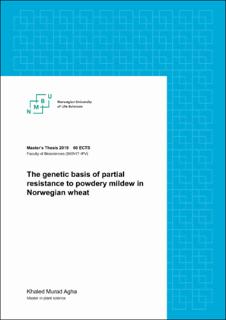| dc.description.abstract | Powdery Mildew caused by (Blumeria graminis) is a major problem for cereal production, especially wheat (Tritium aestivum), and is an ever-occurring pathogen in Norway. One way for developing wheat cultivars with effective and long-lasting resistance to powdery mildew is to incorporate different Quantitative Trait Loci (QTL) conveying partial resistance. In this study, 296 spring wheat, and 103 winter wheat lines from a collection of wheat lines and cultivars that cover all current and historically important Norwegian cultivars were used. The main objective of the study was to find QTL associated with powdery mildew resistance in the wheat and identify which QTL provides the best resistance. The collected data was from four different localities in different years ranging from 2012 to 2019. The collection was previously genotyped with 35k Affymetrix-SNP array. A total of 14136 and 14089 markers were used for the spring and winter wheat lines respectively, to perform a genome-wide association study. This resulted in identification of QTL shown to be significantly associated with powdery mildew infection, eleven in spring wheat experiments and seven in winter wheat experiments. These QTL were compared with previously documented genes and QTL to establish if the QTL found in present study are previously described or possibly novel that can possibly be used in resistance breeding. In Spring wheat, the 7DS (55 Mbp) QTL is possibly the same as the described Pm38/Lr34/Yr18 gene. The 7BL (709-713 Mbp) QTL is possibly the same as Pm5a. The 2BS (9-19 Mbp), 3AL (621-623 Mbp), 6AL (602-609 Mbp) and 7BL (637 Mbp) QTL are the most important against powdery mildew in MASBASIS lines, moreover, the 7BL and 6AL QTL are possibly pleiotropic to yellow rust, and the same is possible for 6AL with regard to fusarium head blight. In winter wheat, the QTL on 6AL (446-454 Mbp), 7AS (26-30 Mbp) and the second QTL on 7AS (28-33 Mbp) are also recommended for improving powdery mildew resistance. | en_US |

